Accepted Scientific Name: Agave filifera Salm-Dyck
Hort. Dyck. (1834) 309.
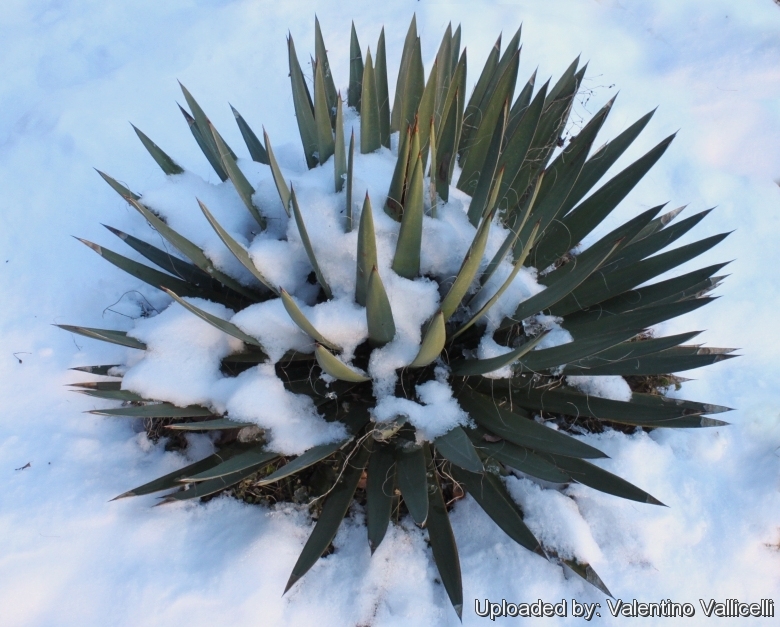
Bonapartea filamentosa (Agave filifera) Photo by: Valentino Vallicelli
( Thread-leaf Agave ) Forms tight rosettes of narrow, hairy, stiff dull-green leaves with very sharp terminal spines. It is quite frost resistant and can be grown outdoors in most of mild-temperate climates.
Origin and Habitat: Origin uncertain. Probably north Mexico. It is well known in European horticulture, but it is a clonal thing, stemming from one or two introductions there in the last century.
Synonyms:
See all synonyms of Agave filifera
Common Names include:
ENGLISH: Thread-leaf Agave, Thread Agave
DUTCH (Nederlands): Tråd-Agave
ESTONIAN (Eesti): Kiuline agaav
FINNISH (Suomi): Lanka-agaave
RUSSIAN (Русский): Агава нитеносная, Агава фуркроидная, Агава Хенекен, Агава Генекен
Description: Agave filiferaSN|556]]SN|10450]] is a small to medium sized agave that forms attractive rosette of leathery leaves each ending in a stout stiff spine. The leaves are dark green in colour with ornamental white threads along the edge. This agave will eventually throw up a flower stem 2,5 m at the end of which are purple and green blooms. However, the plant is mainly grown for the attractive rosette of leaves. The main rosette dies after blooming but usually new plantlets sprout from the base to start a new life cycle. It produces suckers freely.
Rosettes: Trunkless, dense, 30 to 65 cm across, with 60-100 thick filiferous leaves.
Leaves: 15-30(-40) cm long, 2-4(-5) cm wide, straight, lanceolate, long-tapering to the apex, narrowed towards the base, broadest in middle, convex above and below from base to mid-blade, stiff, spreading and somewhat upcurved, leathery, smooth, shiny dark green with 2 or 3 bud-prints (white lines) on the surface. Margins pale, horny, splitting off as 5 or 6 long, thin threads. Terminal spine 1-2 cm, brown. later grey, openly grooved above, rounded below.
Inflorescence: Spike, tapered, bottelbrush-like, up to 2,5 m tall flowers very dense through upper half of shaft set with long-caudate recurving bracts.
Flowers: 3-3,5 cm long, bell-like, ascending-outcurving on thick short pedicels, greenish at first, later reddish. Ovary spindle-like, angulate, about 13-15 mm long. Tube and neck, grooved, funnelform. Tepals equal, 14 long and 4 mm wide, recurving, lanceolate, apiculate. Filaments 30-35 mm long, slender, reddish, with a high knee, anthers 7-12 mm long, reddish.
Remarks: It is closely related to Agave schidigeraSN|10450]]SN|556]], from which it is separable by its cespitose habit, its shorter thicker leaves convex beneath, and smaller flowers with a shorter tube.
Subspecies, varieties, forms and cultivars of plants belonging to the Agave filifera group
 Agave filifera Salm-Dyck: Forms tight rosettes of narrow, hairy, stiff dull-green leaves with very sharp terminal spines.
Agave filifera Salm-Dyck: Forms tight rosettes of narrow, hairy, stiff dull-green leaves with very sharp terminal spines. Agave filifera f. cristata: This is one the very few known crested agaves, it forms a strange fan shaped, wavy rosette.
Agave filifera f. cristata: This is one the very few known crested agaves, it forms a strange fan shaped, wavy rosette. Agave filifera subs. schidigera (Lem.) B.Ullrich: Small or medium sized plant that forms stemless rosette to 60 to 90. It is decorated with thin white curly marginal fibres spreading in all directions which sometimes are very dense.
Agave filifera subs. schidigera (Lem.) B.Ullrich: Small or medium sized plant that forms stemless rosette to 60 to 90. It is decorated with thin white curly marginal fibres spreading in all directions which sometimes are very dense. Agave filifera subs. schidigera f. compacta hort.: Very compact, small, symmetrical plant, growing to 20-30 cm wide and 20-25 cm tall. Leaves decorated with thin white curly marginal fibres and with very ornamental white bud imprints.
Agave filifera subs. schidigera f. compacta hort.: Very compact, small, symmetrical plant, growing to 20-30 cm wide and 20-25 cm tall. Leaves decorated with thin white curly marginal fibres and with very ornamental white bud imprints. Agave filifera subs. schidigera cv. Shira Ito No Hoi: Rosette is composed of dark green leaves, each highlighted by a creamy-white border and curly white hairs.
Agave filifera subs. schidigera cv. Shira Ito No Hoi: Rosette is composed of dark green leaves, each highlighted by a creamy-white border and curly white hairs. Agave х leopoldii hort. ex G.Nicholson: Miniature hybrid species (A. filifera x A.filifera var. schidigiera) that has lots of fibres peeling off its short, very narrow leaves, and lots of suckers.
Agave х leopoldii hort. ex G.Nicholson: Miniature hybrid species (A. filifera x A.filifera var. schidigiera) that has lots of fibres peeling off its short, very narrow leaves, and lots of suckers. Agave х leopoldii cv. Hammer Time: The leaves are slightly elongated with a golden stripe down their edges.
Agave х leopoldii cv. Hammer Time: The leaves are slightly elongated with a golden stripe down their edges.
Bibliography: Major references and further lectures
1) Howard Scott Gentry “Agaves of Continental North America” University of Arizona Press, 01/Feb/2004
2) Urs Eggli “Illustrated Handbook of Succulent Plants: Monocotyledons” Springer, 2001
3) Hermann Jacobsen ”A Handbook of Succulent Plants: Abromeitiella to Euphorbia” Blandford Press, 1960
4) Stuart Max Walters “European Garden Flora: A Manual for the Identification of Plants Cultivated in Europe, Both Out-of-Doors and Under Glass” Cambridge University Press, 1984
5) Breitung, A. J. (1962); "Cultivated and native Agaves in the South-western United States" (Part 19; Cact. Succ. J. (USA) 34(2): 42-45.
6) Breitung, A. J(1968): "The Agaves." Cact. Succ. J. (USA) Yearbook, Abbey Garden Press, Reseda.
7) Terraciano, A. (1885): "Primo contributo ad una monografia delle Agave." Stabil. Tipogr. Barnaba Cons di Antonio, Napoli.
8) William Davidson “The illustrated directory of house plants: a practical guide to growing over 500 plants for the home” Salamander, 01/Nov/1990
9) Margaret Martin, Peter Chapman “A gardner's guide to cacti and succulents: how to grow these fascinating plants in the home and greenhouse : featuring 150 species” Salamander Books, Limited, 198
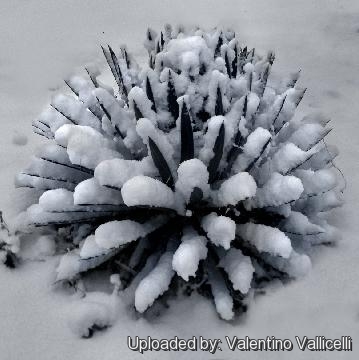 Bonapartea filamentosa (Agave filifera) Photo by: Valentino Vallicelli
Bonapartea filamentosa (Agave filifera) Photo by: Valentino Vallicelli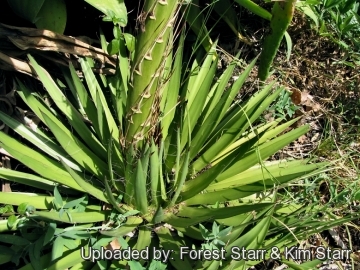 Habit and base of flower stalk at Enchanting Floral Gardens of Kula, Maui, Hawaii, USA. October 20, 2009. (Agave filifera) Photo by: Forest Starr & Kim Starr
Habit and base of flower stalk at Enchanting Floral Gardens of Kula, Maui, Hawaii, USA. October 20, 2009. (Agave filifera) Photo by: Forest Starr & Kim Starr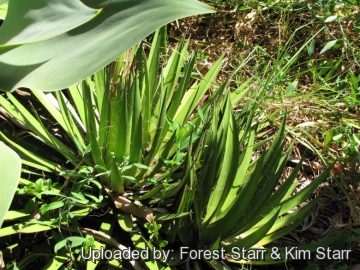 Habit at Enchanting Floral Gardens of Kula, Maui, Hawaii, USA. October 20, 2009. (Agave filifera) Photo by: Forest Starr & Kim Starr
Habit at Enchanting Floral Gardens of Kula, Maui, Hawaii, USA. October 20, 2009. (Agave filifera) Photo by: Forest Starr & Kim Starr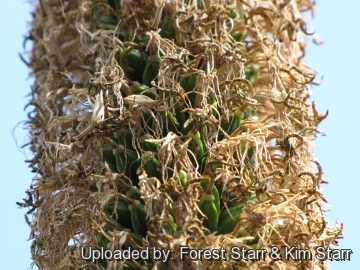 Spent flowers and immature seed pods at Enchanting Floral Gardens of Kula, Maui. October 20, 2009. (Agave filifera) Photo by: Forest Starr & Kim Starr
Spent flowers and immature seed pods at Enchanting Floral Gardens of Kula, Maui. October 20, 2009. (Agave filifera) Photo by: Forest Starr & Kim StarrCultivation and Propagation: It is an easy-to-grow plant often grown as a houseplant.
Growth rate: Plants have a moderate growth rate and form clumps given the best conditions.
Soil: They are tolerant of most soils, but do best in very well-drained, sandy or gravely soil. As ornamental they are also grown in containers where they stay much smaller than their outdoor brethren. In pots they need a very porous mix soil (e.g. 2 parts peat moss to 1 part loam to 1 part of pumice).
Exposure: They do well in full sun or a lightly shaded area with afternoon shade. Plants cultivated outdoors are drought tolerant and takes blasting heat and full sun.
Repotting: Use pot with good drainage.
Watering: It grows fairly fast in summer if provided with copious water but allows to dry thoroughly before watering again. During the winter months, one should only water enough to keep the leaves from shriveling. Avoid waterlogged conditions.
Fertilization: They grows quickly if kept well nourished with a slow release fertilizer specifically formulated for cactus and succulents applied once or twice a year in the spring and summer (poor in nitrogen), including all micro nutrients and trace elements.
Hardiness: It is theoretically hardy to -10° C , particularly when dry. Keep it in a cool area in winter and put it out on the balcony or patio in summer. It is damaged from early morning overhead watering in the winter. The water froze resulting in pockmarks on the leaves.
Scenography: It is quite versatile. Because of its symmetrical form and relatively small size, this plant is very attractive when grown in pots. Plants can be grouped together or planted among boulders in a rock or cactus garden. It is great in small pots or nestled into a rock crevice.
They work well with perennials.
Traditional uses: The sap of is fermented to make a light alcoholic Mexican drink called 'pulque'. Rope, food, soap and other products are also made from the fibers and pulp.
Warning: It is armed with sharp spines.
Propagation: By suckers which often are found growing around the base of the plant, Remove the basal suckers (if available) in spring or summer and let the cuttings dry for a few days before inserting in compost or by seed.














